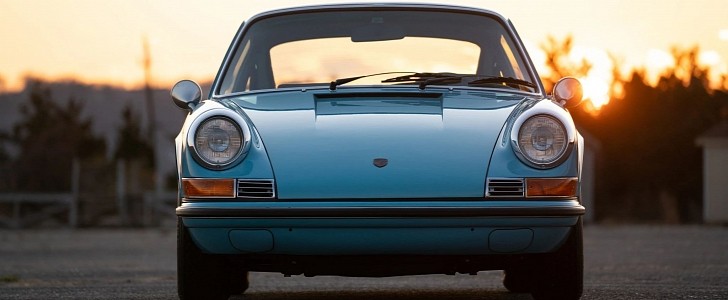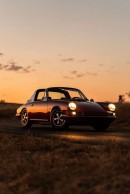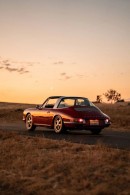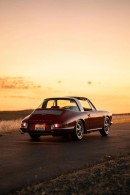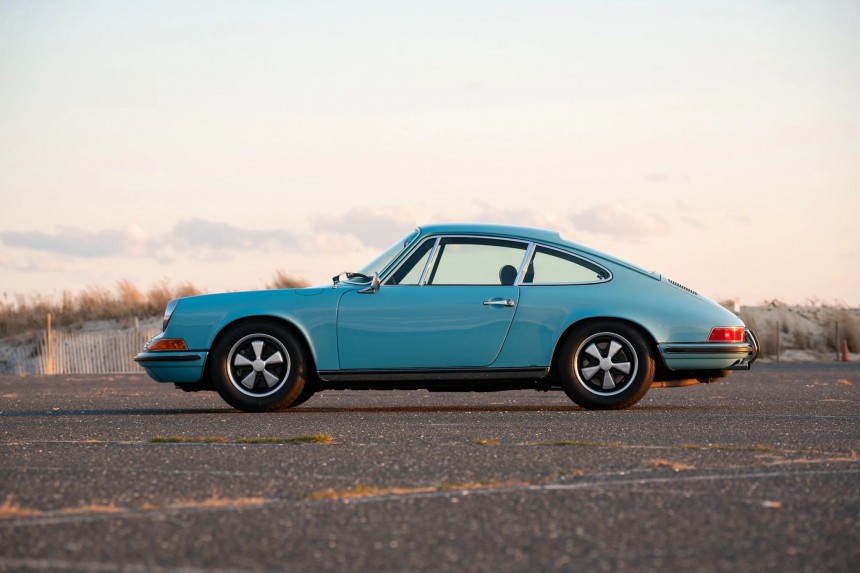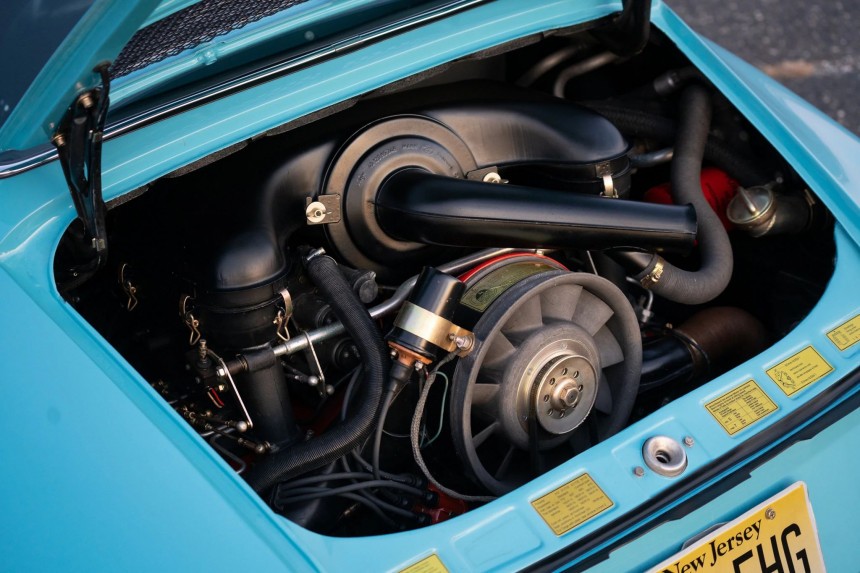Offered between August 1964 and July 1967, the O-series 911 sold just under 13,000 units. Come August 1967, the A-series 911 rolled out for the 1968 model year, then Porsche discontinued this fellow the following August in favor of the B-series 911 for the 1969 model year.
The unibody design of the O series carried over pretty much unchanged to the A-branded successor, which features single-wishbone MacPherson struts up front and semi-trailing arms out back. Torsion bars and telescopic shocks are featured on every corner of the Neunelfer from this era, along with an anti-roll bar for the mid-range 911 and luxury-oriented 911 L. The entry-level 911 T doesn’t feature one, while the go-faster 911 S came standard with a slightly thicker anti-roll bar than the 911 and the snazzier 911 L.
Of these main variants, only two were sold in the United States. More specifically, the six-pot boxer fitted to the North America-bound 911 and 911 L is rocking a belt-driven exhaust air pump. In addition to a four-speed manual for the 911 T and five-speed manuals for the remainder of the lineup, Porsche offered a semi-automatic box as well. Developed in collaboration with Fichtel & Sachs, the Sportomatic four-speed integrates a vacuum-operated clutch as well as a flywheel-replacing torque converter.
All four variants came with 1,991-cc engines featuring an 80-millimeter bore and 66-millimeter stroke. Constructed exclusively from aluminum alloy, the dry-sumped powerplant of the A-series 911 is a SOHC design that employs a couple of Weber 40 carburetors. The 911 T came with the 40 IDT, the 911 and 911 L with the 40 IDA, and the 911 S with the 40 IDS. The 901/03 six-cylinder engine of the 911 T makes do with 108 horsepower at 5,800 revolutions per minute. Stepping up to the performance-oriented 911 S unlocks a few more, as in 158 horsepower at 6,600 revolutions per minute.
Under the front lid, you’ll find a fuel tank with a capacity of 62 liters (16.4 U.S. gallons or 13.6 British gallons). Disc brakes were standard issue for all of the aforementioned variants, along with a dual circuit brake system. The 911 S and 911 L sweetened the deal with ventilated rather than solid rotors. Five-spoke Fuchs forged alloys were offered across the board, these wheels being standard on the 911 S. This iconic wheel design wouldn’t have been possible without input from “Butzi” Porsche and modeler Heinrich Klie.
The remainder of the lineup came standard with 15- by 4.5-inch steelies. The Fuchs measure 15 by 5.5 inches. Compression ratios for the air-cooled boxer range from 8.6:1 in the 911 T to 9.8:1 in the 911 S. How can the A series be differentiated from the B series from a visual standpoint? The answer is black rather than chrome windshield wiper arms, together with thicker cooling slats on the rear lid, separate instead of connected lettering on the engine cover, and exterior door handles with elegantly recessed push buttons.
Aesthetic differences further include anodized aluminum rather than chrome-finish brass for the window frames. Tipping the scales at just under 1,100 kilograms (2,425 pounds) for the 911 T coupe, the A series could be specified as a Targa with actual glass for the rear window instead of a plastic screen. The four-spoke steering wheel frames no fewer than five gauges, with the tachometer located bang in the middle, as you’d expect of a 911.
Notable options include a rear wiper and an electric sunroof. A little over 5,200 coupes and 1,900 Targas were produced for the 1968 model year, which brings us to the B-series 911 that features 57 additional millimeters in wheelbase. Why did the brilliant minds in Zuffenhausen extend the wheelbase? Handling rather than rear legroom was at the top of their priorities list, making the 911 that little bit more controllable on the limit.
The 1969 model year Neunelfer also flaunts different ratios, a beefier alternator connected to a pair of batteries, larger brakes out back, and torsion bar covers located further ahead of the rear wheel arches. The B series further boasts die-cast magnesium for the valve covers and crankcase, a different spare wheel recess up front, larger indicators and larger side mirrors, a standard heated rear window, as well as standard tinted glass.
The B series can also be differentiated by means of slightly more flared wheel arches, exterior vents on both sides of the roll hoop of the Targa, narrower front grilles, and slightly different instrumentation. The German automaker had also equipped the 911 E – which replaced the 911 and 911 L - and 911 S with mechanical fuel injection and capacitor discharge ignition to comply with the stringent emission regulations in the United States of America.
An updated ventilation system and black coat hooks instead of the previous beige-finished units also need to be mentioned. Easily identifiable thanks to the green shroud, the boxer in the B-series 911 features the same 8.6:1 compression ratio as before in the 911 T. Porsche, however, increased it to 9.1:1 in the 911 E to 9.9:1 in the 911 S to squeeze out a few more ponies.
Output ratings start at 108 horsepower for the T and 138 horsepower for the E, whereas the S belts out 168 horsepower. The T, obviously enough, still used Weber 40 IDT carburetors to keep the production costs low. On the other hand, the 901/03 engine of the T received the valve springs of the 901/09 and 901/10 engines used in the E and S. Over in the United States, the 2.0-liter boxer in the B-series 911 T received the 901/16 designation.
In terms of extras, prospective customers were presented with an electric radio antenna, a limited-slip differential, and more bolstered seats from Recaro. Coupe production totaled a little over 7,300 cars, whereas the Targa from the B-series 911 tallied more than 2,700 examples. The C-series 911 would replace the B series in August 1969 for the 1970 model year.
Of these main variants, only two were sold in the United States. More specifically, the six-pot boxer fitted to the North America-bound 911 and 911 L is rocking a belt-driven exhaust air pump. In addition to a four-speed manual for the 911 T and five-speed manuals for the remainder of the lineup, Porsche offered a semi-automatic box as well. Developed in collaboration with Fichtel & Sachs, the Sportomatic four-speed integrates a vacuum-operated clutch as well as a flywheel-replacing torque converter.
All four variants came with 1,991-cc engines featuring an 80-millimeter bore and 66-millimeter stroke. Constructed exclusively from aluminum alloy, the dry-sumped powerplant of the A-series 911 is a SOHC design that employs a couple of Weber 40 carburetors. The 911 T came with the 40 IDT, the 911 and 911 L with the 40 IDA, and the 911 S with the 40 IDS. The 901/03 six-cylinder engine of the 911 T makes do with 108 horsepower at 5,800 revolutions per minute. Stepping up to the performance-oriented 911 S unlocks a few more, as in 158 horsepower at 6,600 revolutions per minute.
Under the front lid, you’ll find a fuel tank with a capacity of 62 liters (16.4 U.S. gallons or 13.6 British gallons). Disc brakes were standard issue for all of the aforementioned variants, along with a dual circuit brake system. The 911 S and 911 L sweetened the deal with ventilated rather than solid rotors. Five-spoke Fuchs forged alloys were offered across the board, these wheels being standard on the 911 S. This iconic wheel design wouldn’t have been possible without input from “Butzi” Porsche and modeler Heinrich Klie.
Aesthetic differences further include anodized aluminum rather than chrome-finish brass for the window frames. Tipping the scales at just under 1,100 kilograms (2,425 pounds) for the 911 T coupe, the A series could be specified as a Targa with actual glass for the rear window instead of a plastic screen. The four-spoke steering wheel frames no fewer than five gauges, with the tachometer located bang in the middle, as you’d expect of a 911.
Notable options include a rear wiper and an electric sunroof. A little over 5,200 coupes and 1,900 Targas were produced for the 1968 model year, which brings us to the B-series 911 that features 57 additional millimeters in wheelbase. Why did the brilliant minds in Zuffenhausen extend the wheelbase? Handling rather than rear legroom was at the top of their priorities list, making the 911 that little bit more controllable on the limit.
The 1969 model year Neunelfer also flaunts different ratios, a beefier alternator connected to a pair of batteries, larger brakes out back, and torsion bar covers located further ahead of the rear wheel arches. The B series further boasts die-cast magnesium for the valve covers and crankcase, a different spare wheel recess up front, larger indicators and larger side mirrors, a standard heated rear window, as well as standard tinted glass.
An updated ventilation system and black coat hooks instead of the previous beige-finished units also need to be mentioned. Easily identifiable thanks to the green shroud, the boxer in the B-series 911 features the same 8.6:1 compression ratio as before in the 911 T. Porsche, however, increased it to 9.1:1 in the 911 E to 9.9:1 in the 911 S to squeeze out a few more ponies.
Output ratings start at 108 horsepower for the T and 138 horsepower for the E, whereas the S belts out 168 horsepower. The T, obviously enough, still used Weber 40 IDT carburetors to keep the production costs low. On the other hand, the 901/03 engine of the T received the valve springs of the 901/09 and 901/10 engines used in the E and S. Over in the United States, the 2.0-liter boxer in the B-series 911 T received the 901/16 designation.
In terms of extras, prospective customers were presented with an electric radio antenna, a limited-slip differential, and more bolstered seats from Recaro. Coupe production totaled a little over 7,300 cars, whereas the Targa from the B-series 911 tallied more than 2,700 examples. The C-series 911 would replace the B series in August 1969 for the 1970 model year.
